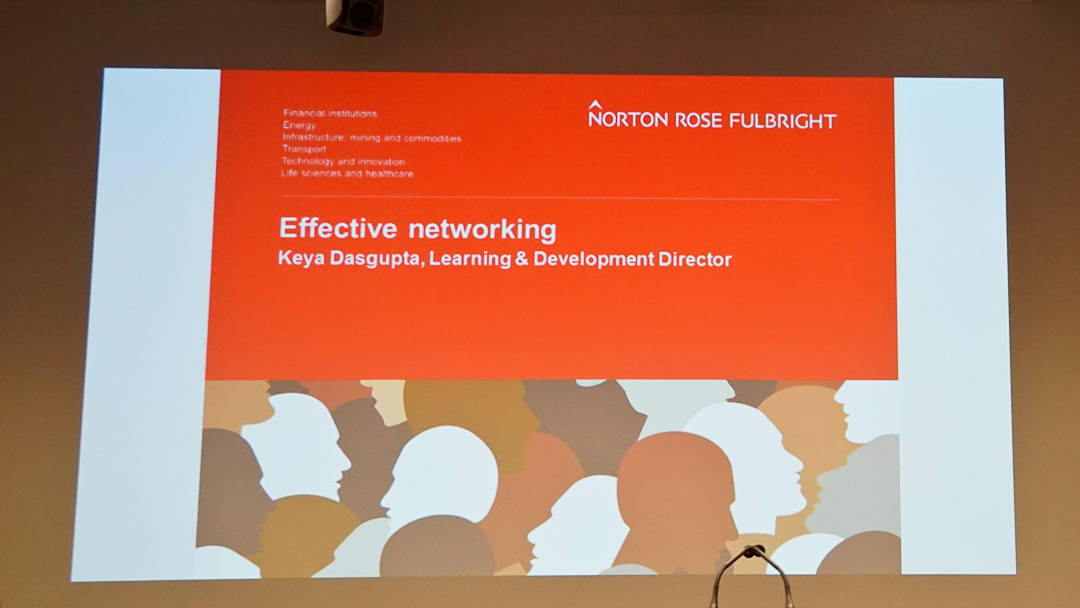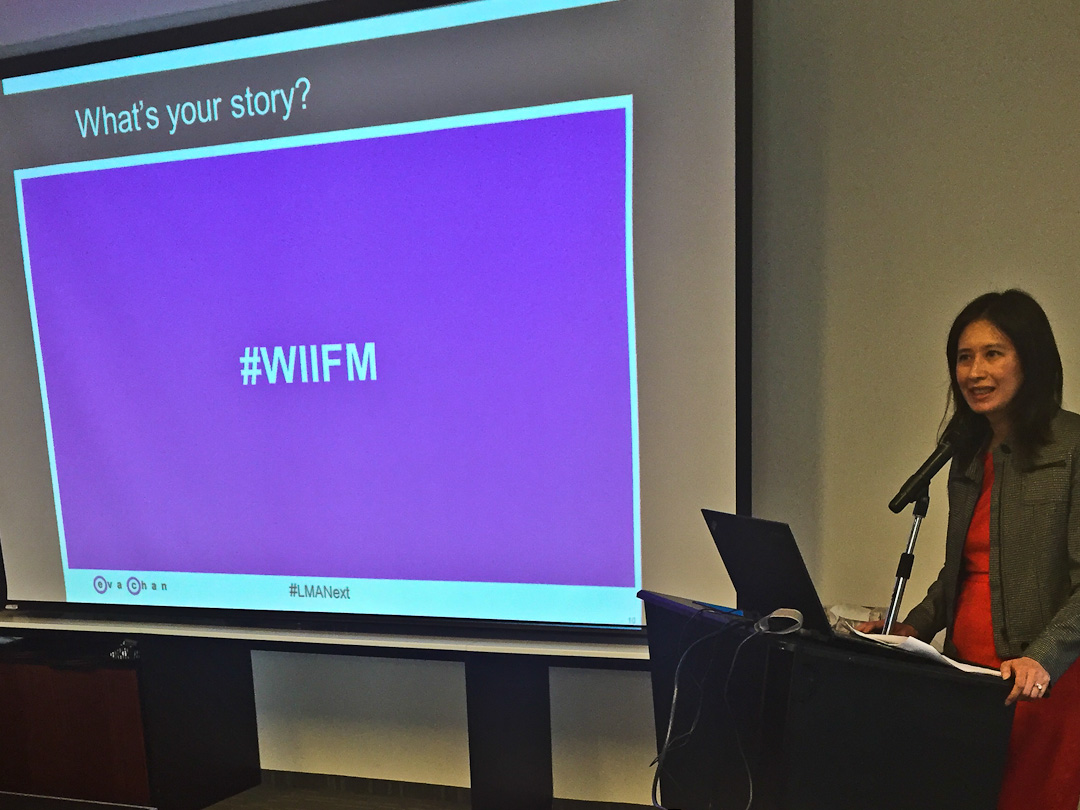
Change That Negative (Social) Networking Mindset
Can networking in person actually be enjoyable? Can social media really improve your networking efforts?
Based on my personal experience, yes! I’ve found that relationships can grow from getting to know what someone posts and engages with on social media, and from interacting with the person on social networking platforms. On many occasions when I finally meet an online contact in person for the first time, the engagement flows as though we were high school classmates.
Wouldn’t you like that sense of connection? Wouldn’t that make networking more enjoyable?
 The concept of enjoying your networking experience was expressed by Keya Dasgupta at last month’s Asian and South Asian Heritage Month Program 2018 held at the Law Society of Ontario. Keya, Learning & Development Director at Norton Rose Fulbright, shared practical networking tips during her “Effective networking” presentation.
The concept of enjoying your networking experience was expressed by Keya Dasgupta at last month’s Asian and South Asian Heritage Month Program 2018 held at the Law Society of Ontario. Keya, Learning & Development Director at Norton Rose Fulbright, shared practical networking tips during her “Effective networking” presentation.
She began her presentation by saying that through practice and application of certain strategies, networking can become less daunting and maybe even enjoyable. Later on she mentioned that there isn’t a singular profile of the “perfect networker”; great networkers come in many forms. Phew – we need not strive to be someone we’re not.
Her presentation resonated with me a lot. I’m sure I nodded my head in agreement each time she mentioned the use of LinkedIn to improve our networking experience and outcome.
Here are some of the networking tips Keya encouraged us to apply:
1. Prepare for the Event
Before arriving, take a minute to reflect why we, as well as others, are attending the event in the first place.
Set goals in relation to the event and take the time to write them down. Keya provided the example of “I’ll meet 2 – 3 new people before leaving the event”, which is a SMART – specific, measurable, achievable, realistic and timed – goal.
Also she reminded us to research our own organization because when we attend events, we’re representing our organization. LinkedIn was mentioned as a way to do this.
Further Keya suggested we find out who will be attending the event. If there is someone in particular we’d like to meet, we can ask the host for an introduction. Along these lines, I’d like to share some additional tips from my social media presentation at one of the recent Ontario Bar Association’s Managing Partner Roundtables:
- Review the social media feeds of an event organizer to find out who may be attending the event.
- If there is a hashtag associated with the event, click on the hashtag and see who else is engaging with it.
- Learn more about those who say they’ll be attending the event by looking at their social media profiles and posts, as well as their website bios.
- Identify the attendees you’d like to speak with at the event and commit to making it happen.
2. Listen
Keya recommended that when networking, we should listen more than we talk – 70% listening, 30% talking. We’re listening for commonalities to help the conversation flow. Also we’re networking to gather information and learn about “new ventures and spot new business opportunities”, as Keya related. Networking is not about “asking for the big ask”.
While we’re listening, we should not be scanning the room for the next person to approach. Maintain eye contact with the person you’re in conversation with.
I agree that listening is an important aspect of networking. Hopefully that will reduce the stress level for other introverts (like me). Although social media gives us a voice to build our profile and increase others’ awareness of who we are without ever attending a networking event, we also need to use social media and in-person events to listen. What we learn from listening can help us better understand what our contacts are truly interested in so we can share content they will find to be relevant and useful. Listening also helps us be more memorable to the person we’re trying to connect with. Listening on social media is much more than reading what people post; it includes paying attention to whether people are engaging with the content – are people clicking to read the content that you share? If not, re-consider what you think is of interest to them.
3. Create a Follow-up Habit
Keya noted that it takes 6 – 8 points of contact with a person before you’re formally included in their network, so it’s a “slow build”. Thus it’s important to form a habit to follow up with the person you want to build a relationship with.
Some examples Keya gave for relationship building included phoning those you met or connecting with them on LinkedIn and engaging with news related to the person (e.g., congratulating them on an achievement either by phone, email or social media).
After hearing Keya’s presentation, I knew I had to share some of her valuable networking tips with you. I also emailed her a few follow-up questions for this blog post.
Question: Did you always find networking to be enjoyable? If not, do you recall what changed your attitude towards it?
Keya:
Although I train on the topic of networking, I will admit that when I first entered the legal profession, I too found networking to be challenging. My discomfort was based on a feeling that I didn’t belong in the setting, concern that I might come across as uninformed or unintelligent and anxiety about the moments in between conversations when I might be alone. What helped me develop a more positive attitude toward networking was shifting from this place of navel-gazing to a mindset of curiosity around networking situations – Who will I meet? What will I learn? What hors d’oeuvres will be served? I’m only slightly kidding on that last one. Even after many years of experience in networking settings, I still feel slight trepidation just prior to an event but my mantra of “be curious” helps ground me in the mindset I choose to inhabit.
Question: What suggestions do you have for creating a follow-up habit for the “slow build”, as it’s very easy for lawyers to push non-billable activities lower down their list of things to do? Also, for some, the follow-up may be viewed as an “ask” or a selling activity and, thus, an unpleasant task to do.
Keya:
The best advice I can give to lawyers, who are often over-achievers, is to keep their goals realistic. Instead of setting an all-or-nothing goal of following up with everyone who provides you with a business card, contact 1 or 2 people with whom you’ve made a meaningful connection. Where possible, set the stage for the follow-up communication before ending the networking conversation. For instance, if I were chatting with someone about yoga, I would offer to email them my list of favourite studios. Follow-up doesn’t always have to relate to work. It can be about anything that builds the connection between you and your contact.
Question: Those are great suggestions. Do you have any further tips related to the use of social media and networking?
Keya:
LinkedIn is a very useful tool for pre-networking event research. I find it really handy to look up the profiles of attendees prior to an event to find out whether we have any common connections. I’ve used this information to break the ice at the outset of a conversation. By leveraging the credibility of a common contact, you are able to build immediate rapport.
Thank you, Keya, for these additional words of wisdom!
I hope you can see that it’s possible to enjoy networking. Social media can help in part with that process, along with the “slow build” to be part of someone’s network. Focus on building and nurturing relationships. Happy (social) networking!



